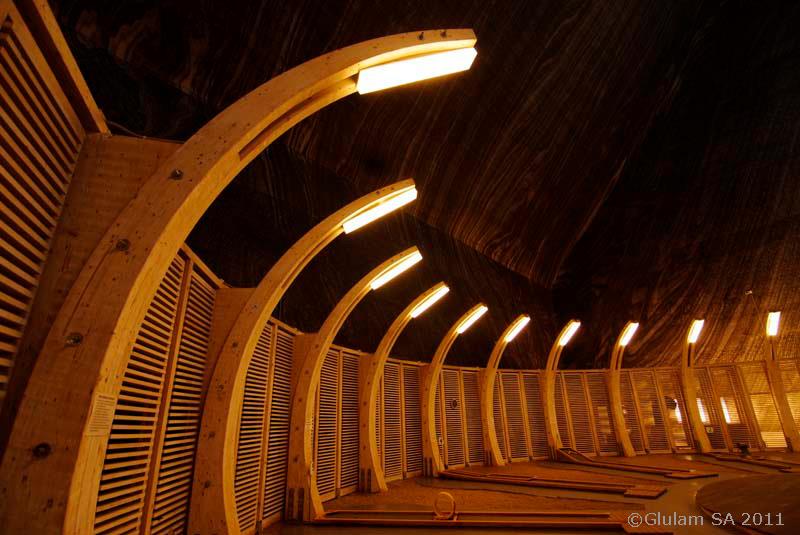GLULAM is the international term for lamellar beamsThe term comes from Glued Laminated Timber. The product is a wood composite consisting of layers of lumber (planks) butt-jointed together to the desired size, which are pressure-glued together widthwise with a very strong adhesive.
A durable material used successfully in construction
Glulam beams are used to obtain strength structures, i.e. columns, beams, frames, etc. They can also be obtained in curved shapes, having a bending strength 50% higher than that of solid wood. The sandwich also reduces the stresses that occur in solid wood, resulting in a material that deforms and cracks less easily.
Another advantage of the material is that it allows the removal of certain defects in the timber, knots, cracks, which would create problems in a strength structure. The pieces resulting from the removal of defective parts are joined into teeth and then glued. The adhesive layers formed make the material fire resistant. When fire reaches the adhesive, it extinguishes itself.
One of the earliest surviving buildings to use glulam beams for the roof is the assembly hall of King Edward VI College in Southampton, England, dating from 1866. It now serves as the town hall marriage hall.
A history of almost 150 years
But the first industrial patent was registered in Weimar, Germany, in 1906, by Otto Hetzer, a highly inventive German. As early as 1872, he had already set up a steam-powered gater and a carpentry shop. Here he developed many innovative ideas which he began patenting in 1892. The patent registered in 1906 is practically the birth certificate of the lamellar beam.
In 1909, Terence & Chopard, a Swiss building consultancy, bought the patent and used the beams in a series of projects.
One of the projects was the Zurich Hygiene Institute of that time, built in 1911, which later became part of the University of Zurich. The bell-shaped dome, then built using lamellar beams, is still visible today.

In the USA, laminated beams arrived in 1934, thanks to Max Hanisch Sr. who worked with Otto Hetzer around 1900. He sets up a company in Peshtigo, Wisconsin, which will start production on an industrial scale.
A very important moment in the history of laminated beams is 1942. In this year, a totally waterproof adhesive (phenol-resorcinic glue) was introduced, which made it possible to use the beams outdoors.
The strength of lamellar beams makes it possible to build rooms with wide openings
The beams are now used to build sports arenas, industrial halls, bridges, museums, concert halls and many other impressive constructions.
Thanks to their very high load-bearing capacity, even at great lengths, they allow construction without supporting pillars, with large spans. This allows architects to give free rein to their imagination and realize spectacular constructions.


In Romania, there are also well-known factories of lamellar beams in Ulmi, near Targoviste, in Joseni, Harghita or in Voiteg, Timis. There are many places that have been developed using glulam, one of them being Salina Turda.
I hope you find the information useful. As always, additions are welcome. And if you have any questions or queries, please leave them below in the dedicated space. I will be sure to reply.


































[...] of lamellar beams. A great advantage of these houses is that they offer countless possibilities for joining. The beams [...]
[...] with an Olympic swimming pool of 3500 m². The possibility of using glulam beams is an architect's dream because they allow the creation of structures with large spans, and [...]